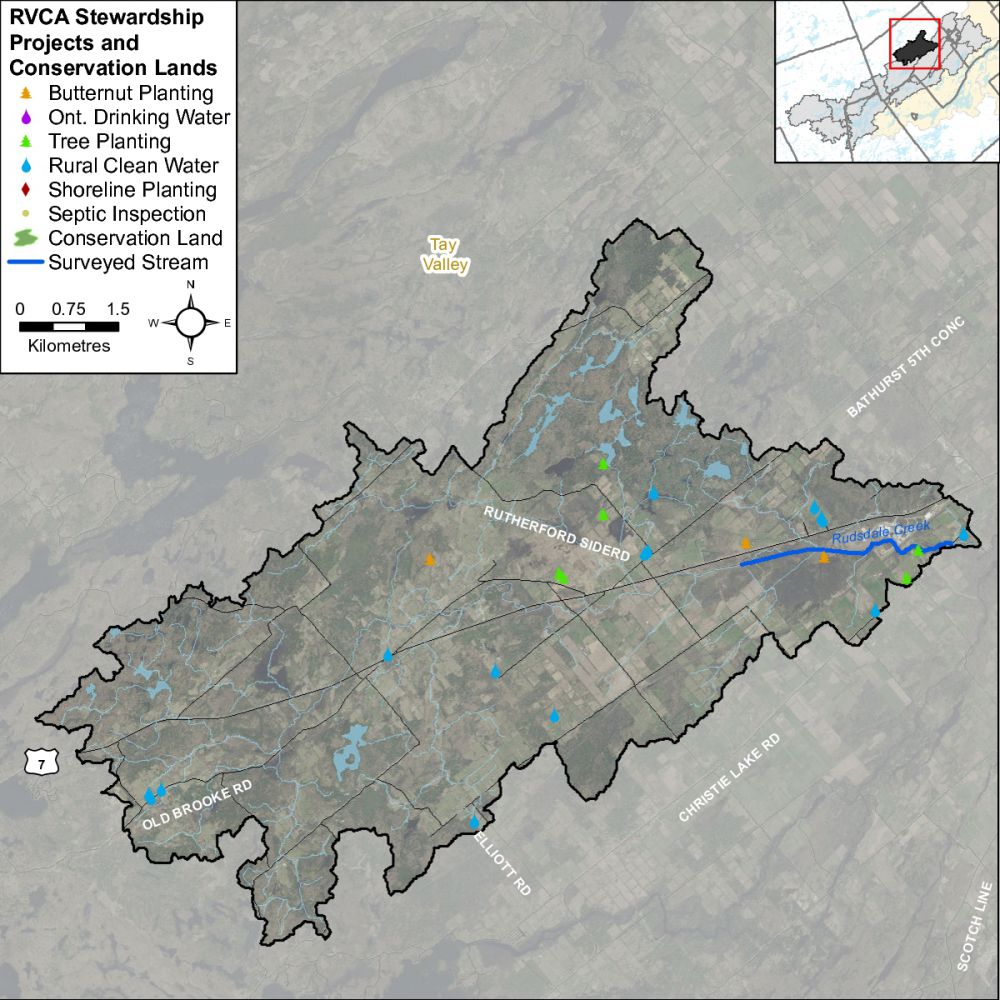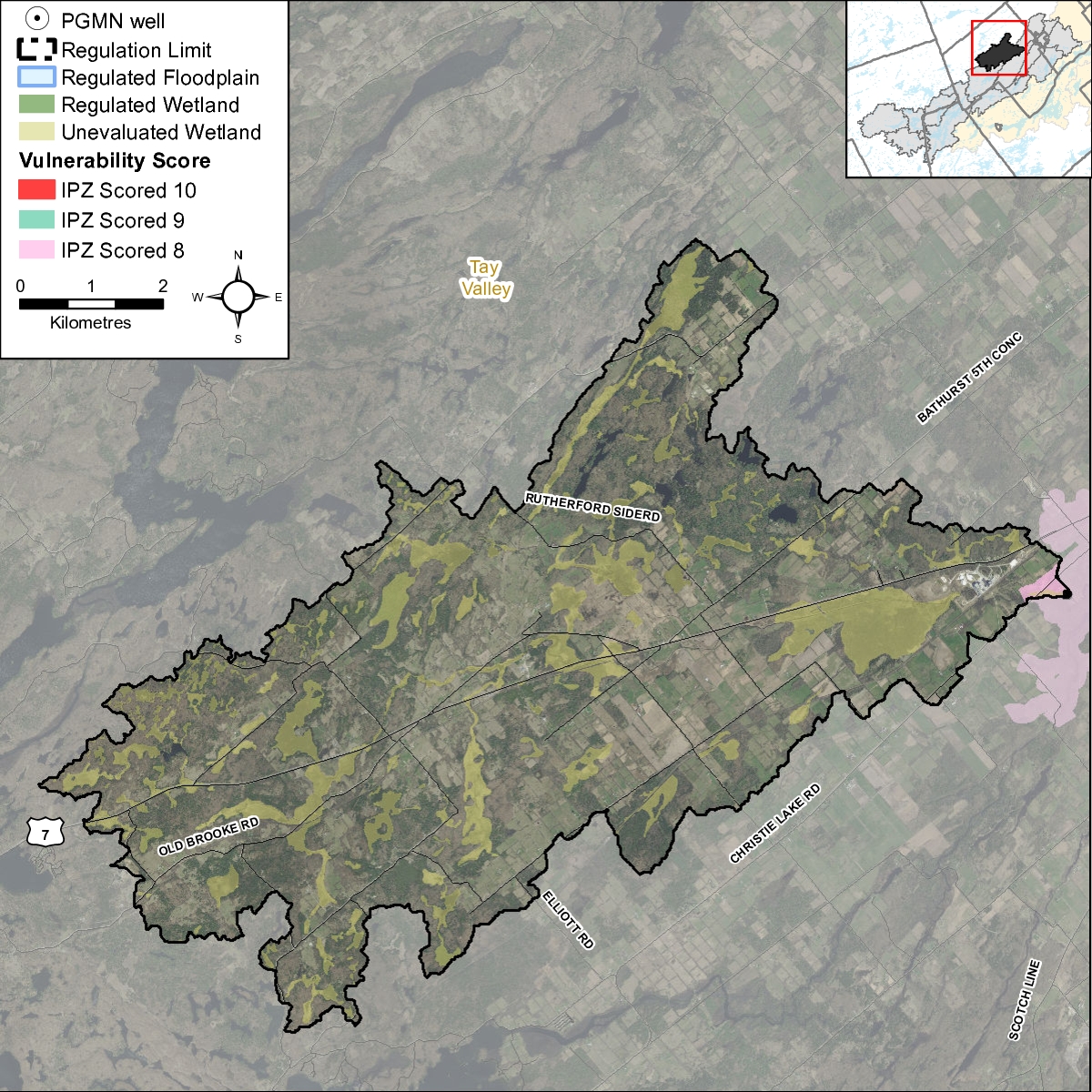5.0 Rudsdale Creek Catchment: Stewardship and Water Resources Protection
The RVCA and its partners are working to protect and enhance environmental conditions in the Tay River Watershed. Figure 55 shows the location of all stewardship projects completed in the Rudsdale Creek catchment.
5.1 Rural Clean Water
The Rural Clean Water Program provides technical and financial assistance to farmers and other rural landowners, to aid in the implementation of projects that protect water quality. Funding is granted to those projects that support best management practices for application in the protection and improvement of surface and ground water resources. The program also supports climate change adaptation and low impact development projects as well as educating rural landowners about environmental stewardship of private property. Examples of supported projects include livestock exclusion fencing, controlled tile drainage, cover crops, erosion control, well related projects, and many more. For a list of eligible projects and to apply for funding, see Rural Clean Water.
In the Rudsdale Creek catchment from 2011 to 2016, six well upgrades, two well decommissionings, two septic system repairs and one manure storage facility were completed; prior to this, two well decommissionings, one well replacement and one well upgrade had been completed. Total value of all 15 projects is $44,451 with $15,353 of that amount funded through grant dollars from the RVCA.
5.2 Private Land Forestry
Forest cover and tree planting continues to be one of the most widely supported strategies to improve our environment. The many benefits of forest cover include carbon sequestration, flood mitigation and water quality improvement as well as providing fish and wildlife habitat.
Through the RVCA's Trees for Tomorrow Program (and its predecessors), 77,300 trees were planted at three sites from 2011 to 2016; prior to this, 20,700 trees were planted at three sites. In total, 98,000 trees have been planted resulting in the reforestation of 49 hectares. Total value of all six projects in the Rudsdale Creek catchment is $267,963 with $220,278 of that amount coming from fundraising sources. For more information about the Program and landowner eligibility, please see the following: Tree Planting in the Rideau Valley Watershed and Trees for Tomorrow.
An additional 30 butternut trees were planted through the RVCA Butternut Recovery Program, as part of efforts to introduce healthy seedlings from tolerant butternuts into various locations across Eastern Ontario.
5.3 Shoreline Naturalization
Natural shoreline buffers rich in native plants are critically important to protecting the health of our lakes, rivers and streams. Shoreline vegetation protects water quality and aquatic habitat by intercepting potentially harmful contaminants such as nutrients, pollutants and sediment, regulating water temperatures, slowing runoff and providing important fish and wildlife habitat. Natural shorelines also help improve climate change resiliency by increasing flood storage and providing protection from erosion during extreme weather events.
As of the end of 2016, no shoreline projects had been carried out in the Rudsdale Creek catchment. Landowners may wish to take advantage of the RVCA's Shoreline Naturalization Program to assist them with the naturalization of their shorelines to see the benefits noted above (and more).
5.4 Valley, Stream, Wetland and Hazard Lands
The Rudsdale Creek catchment covers 62 square kilometres with none of the drainage area being within the regulation limit of Ontario Regulation 174/06 (Figure 56). Wetlands occupy 10 square kilometres (or 16 percent) of the catchment. All are unevaluated and unregulated. Similarly, all 132.7 kilometres of stream in the catchment (including Rudsdale Creek) are not subject to the regulation limit, other than the “alteration to waterways” provision of the Regulation, which affords them some protection.
Nonetheless, efforts (have been made and) continue through RVCA planning and regulations input and review to manage the impact of development (and other land management practices) in areas where “natural hazards” are associated with rivers, streams, valley lands and wetlands. This task is significantly harder, if not impossible to achieve in instances where these features have not been identified on map schedules, as is the case in the Rudsdale Creek catchment. Plotting of the regulation limit along the catchment's watercourses requires the identification of flood and erosion hazards and valley systems.
5.5 Vulnerable Drinking Water Areas
The Town of Perth’s municipal drinking water Intake Protection Zone (IPZ), specifically IPZ-2 with a vulnerability score of 8 is found within the Rudsdale Creek catchment (Figure 56). As per the Mississippi-Rideau Source Protection Plan, policies may affect future development within these areas. Under Section 59 of the Clean Water Act, 2006, future applications under the Building Code and the Planning Act may be screened by the Mississippi-Rideau Risk Management Office. Depending on the proposed activity, additional requirements or restrictions may apply. For more information, please contact the Mississippi-Rideau Risk Management Office at (613) 692-3571.
In addition, the Mississippi-Rideau Source Protection Plan has mapped the southern part of the Rudsdale Creek catchment as within a Significant Groundwater Recharge Area and identified all of the catchment as a Highly Vulnerable Aquifer. This means that the nature of the overburden (thin soils, fractured bedrock) does not provide a high level of protection for the underlying groundwater making the aquifer more vulnerable to contaminants released on the surface. Highly Vulnerable Aquifers characterise 89% of the Region and are considered moderate to low drinking water threats with certain policies that apply; mainly policies regarding waste disposal. All property owners are encouraged to use best management practices to protect sources of municipal drinking water. For more information on source protection best management practices, please visit Protecting Your Drinking Water.

